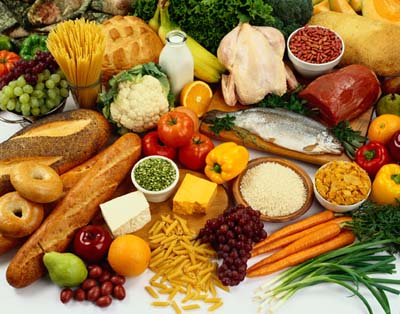Achieving a balanced diet

The old saying “You are what you eat” is only partly true. It takes a great deal more than just food to create a holistically healthy person, but food does form a good foundation on which to build.
We here so much about the “balanced diet”, but even though there is plenty of literature available, it’s not always easy to translate this into the contents of the shopping cart. In order to get and stay healthy, we need to eat foods from all the food groups: Carbohydrates (including fiber), protein, and fats. We also need vitamins, minerals and trace elements, and water.
Carbohydrates and what they do
Carbohydrates come mainly from plant foods. They are the fuel that provides energy and “staying power” for your body. These nourishing foods also contain fiber, minerals, vitamins, and protein. During digestion, carbs are broken down and absorbed into the bloodstream as glucose, which is the primary fuel for the brain. What we now know is that not all carbs were created equal. Different carb foods behave differently in our bodies. Carbs that break down quickly have what are called high GI (glycemic index) values; those that break down slowly, releasing glucose gradually into the bloodstream have lower GI values. For most of us most of the time, low GI foods have advantage over high GI foods, especially for people with diabetes, or heart disease.
Until the last few years, carbohydrates were seen as “fattening”. Foods rich in carbs include:
• Grains and grain foods, including rice, wheat, oats, barley, rye, brad, pasta, noodles, flour, and breakfast cereals.
• All fruits from temperate climates: Apples, pears, peaches, plums, apricots, and oranges. And tropical melons, bananas, pineapples, and berries of all kinds.
• Starchy vegetables such as potatoes, sweet potato, sweet corn, yams, and taro.
• Legumes including beans, chickpeas, lentils, and the favorite stand-by baked beans.
• Dairy products including milk, yoghurt, and ice cream cheese is not a source of carbohydrate, and foods such as butter and cream are primarily a source of saturated fat.
Fiber
Dietary fiber is a carbohydrate made up of material that forms the cell wall of plants.
• Insoluble fiber such as wheat bran can’t be digested by body enzymes and passes as roughage through the body. It works mostly in the bowel where it holds water, creating soft, bulky stools, that are easier to expel. It also helps to control blood sugar and cholesterol levels and is valuable in managing diabetes.
• Soluble fiber, present in oats, legumes, and fruits, is digested by bacteria, and produces valuable acids during the process.
Get an adequate supply of both types of fiber by eating whole grain cereals, washed, unpeeled fruit, salads, and scrubbed, raw or cooked, unpeeled vegetables.

